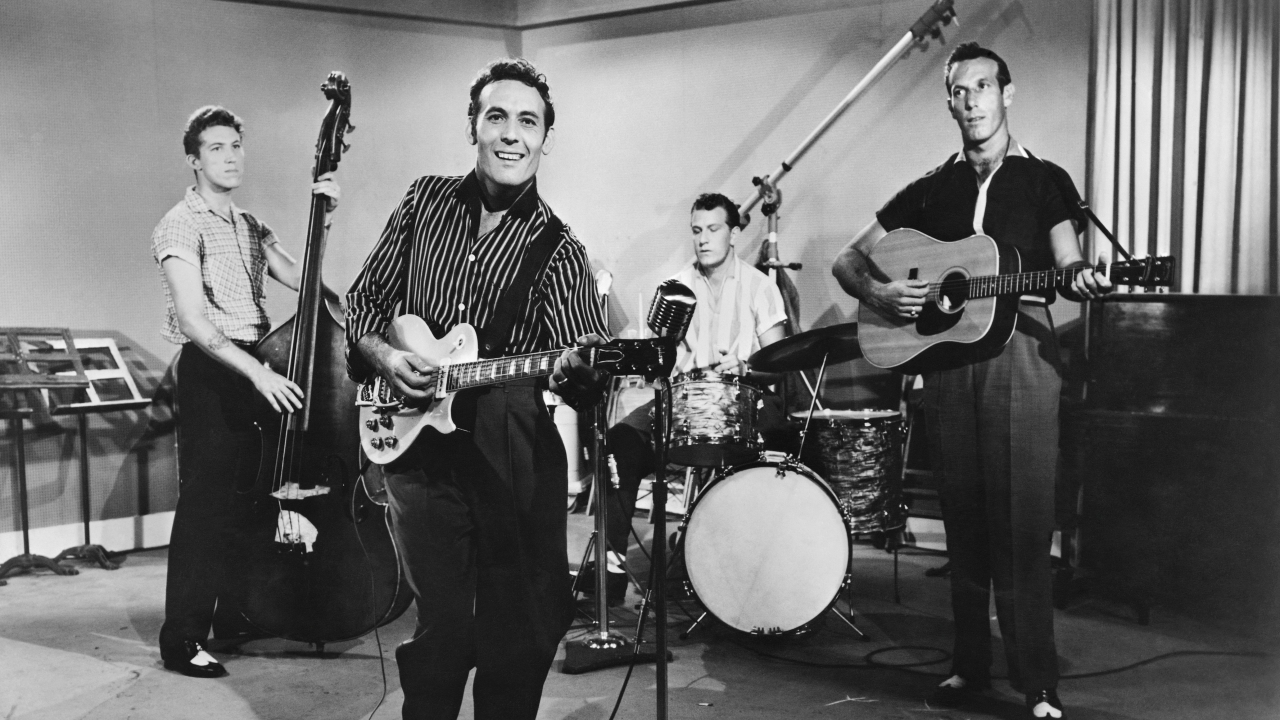Some songs are straight-up classics, others break entirely new ground, a handful even make their way into the wider public consciousness. But it’s debatable whether any song has left as deep an impression on popular culture as Carl Perkins’s Blue Suede Shoes. The first proper rock’n’roll hit, it became the jump-off point for everything that followed.
Perkins’s close friend Elvis Presley recorded it himself soon after, taking it to the American masses via sensational TV appearances on The Dorsey Brothers Stage Show and The Milton Berle Show, and it became the opening shot of his seminal debut album of 1956.
As with many of the greatest songs, Blue Suede Shoes is tied up in myth. Johnny Cash claimed he gifted Perkins the idea after a show late in 1955. Recalling CV White, a soldier he’d served with in the US Army, Cash explained that his friend took particular pride in his footwear during three-day leave. Despite being regulation black, White insisted: “Tonight they’re blue suede. Don’t step on ’em!” Cash said he thought there might be a song in it. Perkins remembered it differently. In his autobiography, Go, Cat, Go!, he wrote that he shrugged off Cash’s initial suggestion, and only conceived the song later.
Today, nearly 60 years after recording Blue Suede Shoes at Memphis’ fabled Sun Studios, the last surviving member of Perkins’s band sets the story straight. “I hear three or four different versions of nearly everything that happened back then,” chuckles drummer WS ‘Fluke’ Holland. “In 1955 we were all on the same booking agency, so the Cash and Perkins bands became really close buddies on tour. This particular time we were driving John’s green fifty-three Plymouth in Arkansas, with Carl and John in the back. He propped his leg up on the back of the front seat and said: ‘Carl, we oughta write a song about some shoes.’ A little bit further on he went: ‘Why don’t we write it about some blue suede shoes?’”
The incident wasn’t mentioned again, claims Holland, until they’d all arrived home a few days later and the Perkins band were playing a tiny club in Jackson. “There wasn’t a stage,” says Holland, “so we just set up in the corner, with Carl’s amplifier on the floor. Somebody danced real close to the amplifier, and we heard this boy howl at his girlfriend: ‘Don’t step on my new shoes!’ Carl went home that night and wrote the words to Blue Suede Shoes.”
Having run through the song with the rest of the band, studio time was booked for December 19. Perkins had already recorded two 45s for Sun boss Sam Phillips: Movie Magg and Let The Jukebox Keep On Playing. The first was pure rockabilly, the second a loping ballad. Blue Suede Shoes was different. Just over two minutes of hip-slapping rhythm, driven by stop-go verses and the fiery treble of Perkins’s guitar, it was a mongrel mix of blues, country and pop. One that defined a new era of anything-goes rock’n’roll.
Holland doesn’t recall much tinkering in the studio, although he does confirm the story that Phillips changed the pivotal intro line from ‘go, man, go!’ to ‘go, cat, go!’ He also concedes that Blue Suede Shoes is far from perfect: “We weren’t actually good enough to work up some kind of arrangement, we just did it the only way we knew how. If you listen to it real close you’ll hear that the intro is not musically correct; there are pauses between each of the phrases – ‘One for the money, two for the show, three to get ready, now go cat go’ – and that was because I didn’t know how to count in. But that’s one of the things that made Sun Records such a big deal. When Sam heard something different, he wouldn’t try to correct it. He’d always leave it that way.”
Released on New Year’s Day 1956, by March the single had reached the Billboard Top 100, where it peaked at No.2, kept off the top spot by Elvis’s Heartbreak Hotel.
Perkins became the first country artist to cross over into both the national and R&B listings. Moreover, Blue Suede Shoes gave Sun Records its first million-seller. The single’s success was enough to set nerves jangling over at RCA, Elvis’s new home. Label boss Chet Atkins supposedly confided to Phillips: “We thought for a while we’d bought the wrong Sun artist.”
Alas, Perkins was never able to capitalise on Blue Suede Shoes. While the original version was still high in the charts, he and the band were en route to New York to appear on Perry Como’s TV show when their car crashed into a poultry truck in Delaware. The truck driver was killed, Jay Perkins broke his neck and sustained internal injuries, while Carl fractured his shoulder and skull.
The accident meant that Perkins was denied the opportunity of being the first rockabilly star to appear on national TV. By the time he’d recuperated, he’d also missed a prestigious slot on Ed Sullivan’s show. But the effects of the crash went beyond his professional life. Brother Jay never fully recovered and, two years later, he died from a brain tumour. Distraught, Carl turned to drink.
The influence of Blue Suede Shoes, meanwhile, was profound. Buddy Holly, Bill Haley and Eddie Cochran all covered it soon after. As a testament to the song’s enduring power, others who have recorded versions over the years include Jimi Hendrix, Lemmy, Black Sabbath, the Grateful Dead and Bruce Springsteen.
The song continued to give its creator an enormous sense of pride. “After all those days in the cotton fields, the dreams came true on a gold record,” Perkins once remarked, remembering his childhood amid the sharecropper poor of Tennessee. “It’s in my den where I can look at it every day. I wear it out lookin’ at it.”

